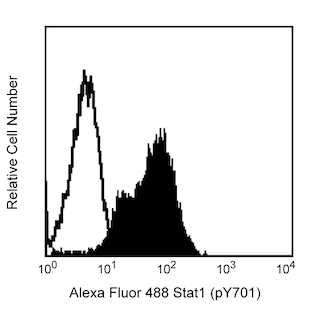Old Browser
This page has been recently translated and is available in French now.
Looks like you're visiting us from {countryName}.
Would you like to stay on the current country site or be switched to your country?


.png)

Analysis of PLK1 (pT210) in human epithelioid carcinoma. Hela S3 cells (ATCC CCL 2.2) were either stimulated with Nocodazole at 37°C for 12-16 hours (shaded histogram) or unstimulated (open histogram). The cells were fixed (BD Cytofix™ buffer, Cat. No. 554655) for 10 minutes at 37°C, then permeabilized (BD Phosflow™ Perm Buffer III, Cat. No. 558050) on ice for at least 30 minutes, and then stained with Alexa Fluor® 488 Mouse anti-PLK1 (pT210). Simultaneous staining with 7-AAD (Cat. No. 559925) demonstrates that the cells with upregulated PLK1 phosphorylation are in the G2/M phase of the cell cycle (data not shown). Flow cytometry was performed on a BD FACSCalibur™ flow cytometry system.
.png)

BD™ Phosflow Alexa Fluor® 488 Mouse anti-PLK1 (pT210)
.png)
Regulatory Status Legend
Any use of products other than the permitted use without the express written authorization of Becton, Dickinson and Company is strictly prohibited.
Preparation And Storage
Product Notices
- This reagent has been pre-diluted for use at the recommended Volume per Test. We typically use 1 × 10^6 cells in a 100-µl experimental sample (a test).
- Caution: Sodium azide yields highly toxic hydrazoic acid under acidic conditions. Dilute azide compounds in running water before discarding to avoid accumulation of potentially explosive deposits in plumbing.
- Source of all serum proteins is from USDA inspected abattoirs located in the United States.
- Alexa Fluor® is a registered trademark of Molecular Probes, Inc., Eugene, OR.
- Alexa Fluor® 488 fluorochrome emission is collected at the same instrument settings as for fluorescein isothiocyanate (FITC).
- The Alexa Fluor®, Pacific Blue™, and Cascade Blue® dye antibody conjugates in this product are sold under license from Molecular Probes, Inc. for research use only, excluding use in combination with microarrays, or as analyte specific reagents. The Alexa Fluor® dyes (except for Alexa Fluor® 430), Pacific Blue™ dye, and Cascade Blue® dye are covered by pending and issued patents.
- For fluorochrome spectra and suitable instrument settings, please refer to our Multicolor Flow Cytometry web page at www.bdbiosciences.com/colors.
- Please refer to www.bdbiosciences.com/us/s/resources for technical protocols.
Companion Products


Polo-like kinase (PLK1) is a serine/threonine kinase with structural similarities to Drosophila's Polo kinase and the Cdc5p of Saccharomyces cerevisiae. Like its invertebrate counterparts, PLK1 activity is required for DNA synthesis and is regulated throughout the cell cycle. Furthermore, PLK1 is highly expressed in primary tumors. It associates with the mitotic spindle during mitosis suggesting that, in addition to its role during S phase, PLK1 may play a role during chromosome segregation. This is consistent with its potential role in cancer development. Threonine 210 (T210) is one of the major phoshorylation sites in activated PLK1 obtained from human mitotic cells.
The K50-483 monoclonal antibody recognizes the phosphorylated T210 of human PLK1.
Development References (4)
-
Ando K, Ozaki T, Yamamoto H, et al. Polo-like kinase 1 (Plk1) inhibits p53 function by physical interaction and phosphorylation. J Biol Chem. 2004; 279(24):25549-25561. (Biology).
-
Jang Y-J, Ma S, Terada Y, Erikson RL. Phosphorylation of threonine 210 and the role of serine 137 in the regulation of mammalian Polo-like kinase. J Biol Chem. 2002; 277(46):44115-44120. (Biology).
-
Peter B, Gleixner K, Cerny-Reiterer S, et al. Polo-like kinase-1 as a novel target in neoplastic mast cells: demonstration of growth-inhibitory effects of small interfering RNA and the polo-like kinase-1 targeting drug BI 2536. Haematologica. 2011; 96(5):672-680. (Clone-specific: Immunocytochemistry (cytospins)). View Reference
-
Yamashiro S, Yamakita Y, Totsukawa G, et al. Myosin phosphatase targeting subunit1 regulates mitosis by antagonizing polo-like kinase1. Dev Cell. 2008; 14(5):787-797. (Clone-specific: Immunofluorescence, Western blot). View Reference
Please refer to Support Documents for Quality Certificates
Global - Refer to manufacturer's instructions for use and related User Manuals and Technical data sheets before using this products as described
Comparisons, where applicable, are made against older BD Technology, manual methods or are general performance claims. Comparisons are not made against non-BD technologies, unless otherwise noted.
For Research Use Only. Not for use in diagnostic or therapeutic procedures.
Report a Site Issue
This form is intended to help us improve our website experience. For other support, please visit our Contact Us page.